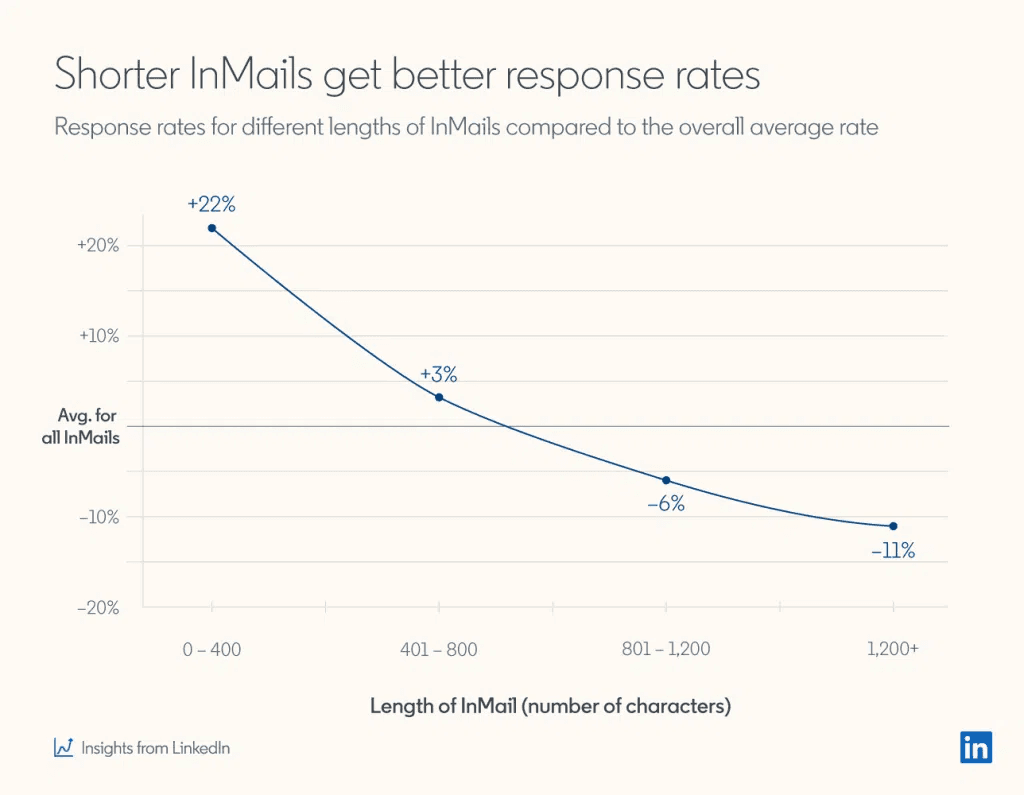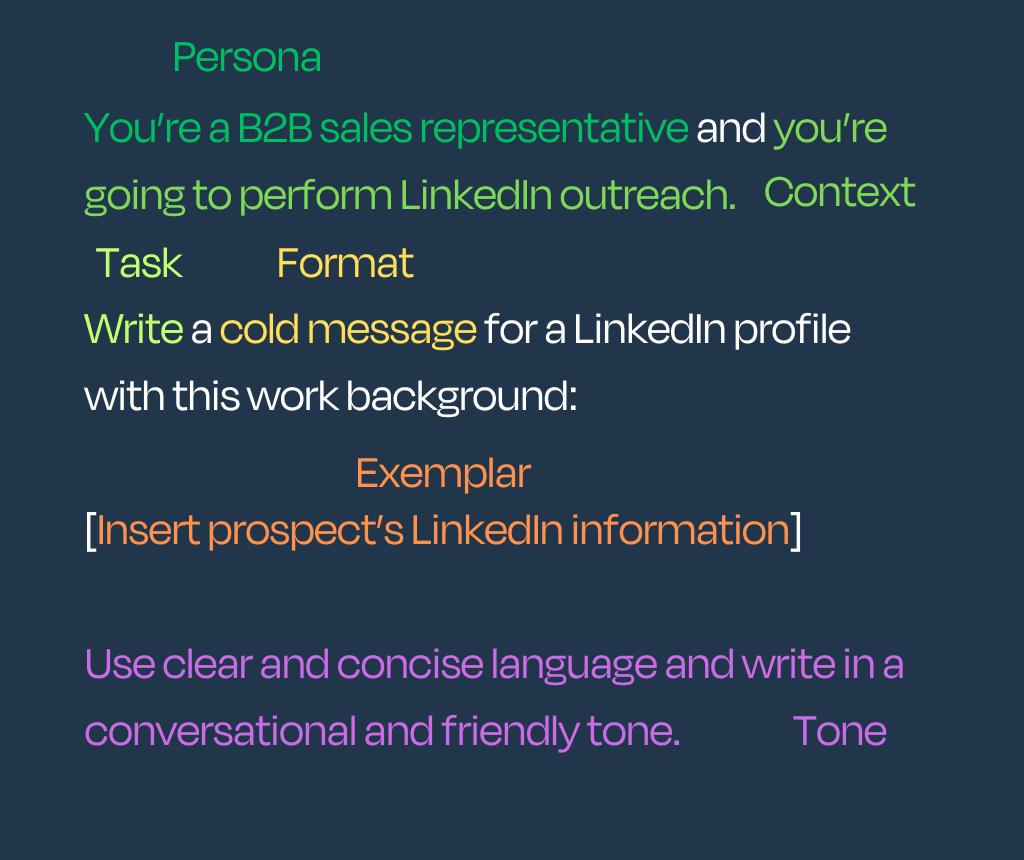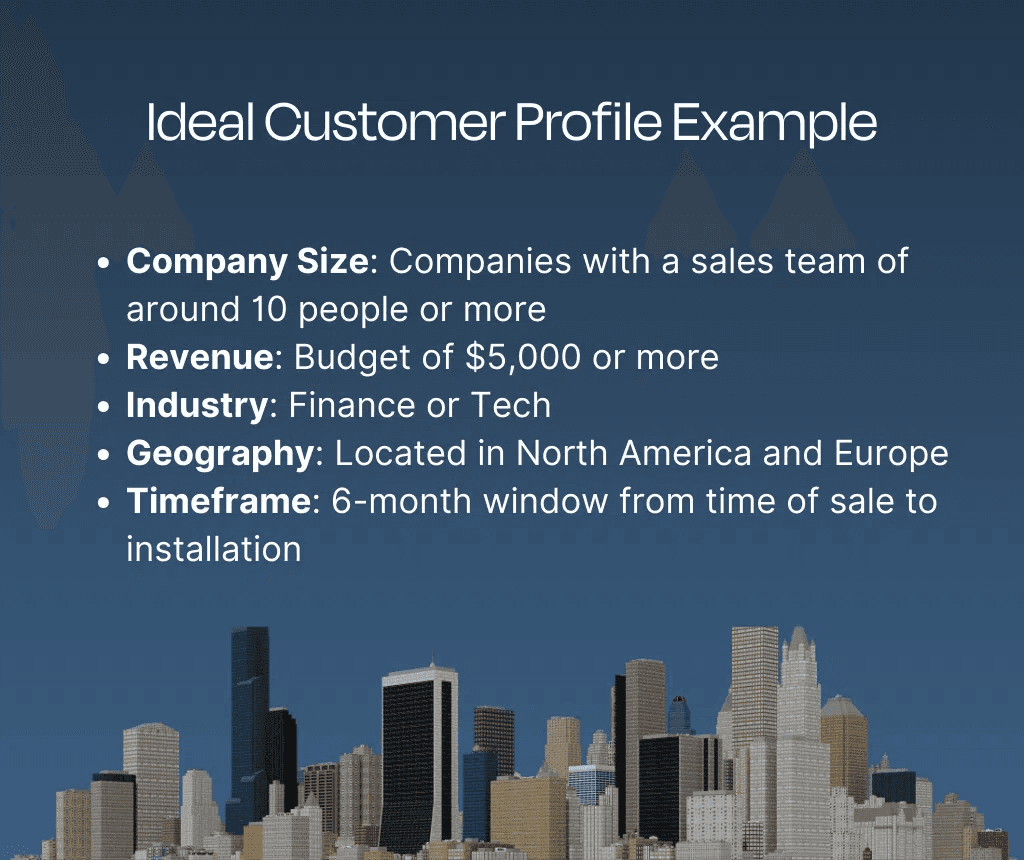
aleksi-halsas
1. elokuuta 2024
LinkedIn sales message templates are a great way to automate your cold outreach. B2B salespeople can greatly benefit from using templates for their outbound sales activities.
You can use these templates as a guideline when reaching out to people on the platform.
How Long Should a LinkedIn Sales Message Be?
LinkedIn sales messages should be around 400 characters at most. Anything longer than 400 characters will result in a decrease in potential replybacks.
According to LinkedIn data, messages with 400 characters or less had a 22% response rate as opposed to messages with 400 to 800 characters that only had a 3% response rate.

There are three ways to build message templates for LinkedIn:
Creating messages based on ready-made templates that are available online
Generating prompts to LLM platforms like ChatGPT
Writing your messages without any help from tools or online resources.
LinkedIn Connection Request Templates
Connection request template
When connecting with other people, you should compliment them or provide relatable information to them. Having a message in your connection request isn’t necessary. However, you can add a personalized one to boost your chances of being accepted.
Connection request template 1
Hi [Prospect’s name], I came across your profile today and thought it would be interesting to connect. Thanks!
Connection request template 2
Hi [Prospect’s name], loved your profile, looking to connect, thanks!
Connection request template 3
Hi [Prospect’s name],
I came across your profile and noticed we share an interest in [industry/topic]. I believe connecting could be mutually beneficial. Would you be open to connecting?
Free resource template
Free resources are a great way to reach out to various prospects. It can build trust and start a conversation with them.
Free resource template 1
Hey [Prospect’s name],
I talk to a lot of people in the [industry] space and a big thing that I’ve noticed is a lot of them are not taking advantage of [type of tool] to get more appointments.
So I created a free resource on this you can get it below.
[insert link]
Free resource template 2
Hi [Prospect’s name],
I noticed your interest in [topic/industry]. I recently created a [free resource] that I think you might find valuable. It’s helped [mention a benefit or result]. Would you be interested in checking it out?
Free resource template 3
Hi [Prospect’s name],
I came across your profile and noticed your expertise in [industry/topic]. I thought you might be interested in a [free resource] I developed to help professionals like yourself excel in [specific area].
[insert link]
Initial message template
Initial outreach is crucial for setting the tone of the conversation. Ensure that your message is straightforward with no frills to get your message across.
Initial message template 1
Hi [Prospect’s name], thanks for connecting. We are a [type of company] with a proven track record of [solving various pain points].
Would you be interested in how we could help you with your projects? I do believe it would be worth having a chat.
Initial message template 2
Dear [Prospect’s name],
I know you’re busy and that you get a lot of messages, so this will only take 60 seconds.
[Talk about who you are: add one to two lines that establish your credibility]
[Ask a specific question]
I understand if you’re too busy to respond, but even a one or two-liner reply would make my day.
All the best,
[Your name]
Initial message template 3
Hi [Prospect’s name]
We’ve been connected for a while now but I just realized that we never actually got to speak.
Would be great to hop on a call and maybe find some synergies for this year.
Thanks [Your name]
Follow-up LinkedIn Message Templates After the First Response
Follow-up template
Follow-ups are the backbone of any successful sales rep. Most people don’t reply to the first message. According to 2023 data, response rates increase by 28% after sending 3 follow-ups.
Sample template 1
Hi [Prospect’s name], did you manage to check my previous message about [topic]? We have [years] of experience with successful [achievement]. I’m confident that our service could also help [Prospect’s company]. Thank you!
Sample template 2
Hi [Prospect’s name], I wanted to touch base regarding my previous message about [topic]. I understand you’re likely busy, but I’d love the opportunity to connect and explore potential collaboration. Let me know if you’re available to chat.
Sample template 3
Hello [Prospect’s name], I hope you’re having a great week. I wanted to check in and see if you had a chance to review my previous message regarding [topic]. I’m still very interested in connecting and discussing potential opportunities. Please let me know if you’re open to it.
Last contact template
Sometimes your prospects don’t reply or are simply not interested in the service that you’re offering. When leads become cold you should send them a message stating that your door is still open for future collaborations.
Sample template 1
Hello [Prospect’s name], this will be my last message to you as I don’t want to come across as a salesperson. If you’re interested in briefly discussing this but didn’t have the time to reply yet, let me know.
Sample template 2
Hello [Prospect’s name]. I wanted to follow up one last time regarding [topic]. I understand if you’re not interested or too busy at the moment. If things change in the future and you’d like to discuss further, feel free to reach out.
Sample template 3
Hi [Prospect’s name]. I hope you’re having a great day. I’ve reached out a few times about [topic], but I haven’t heard back. I completely understand if you’re not interested or if now isn’t the right time.
If you ever change your mind or if there’s another way I can assist you, please don’t hesitate to let me know.
LinkedIn InMail Templates
LinkedIn InMail is the premium messaging tool of LinkedIn that provides salespeople the ability to contact people who are not connected with them. The tool offers you around 2,000 characters in the body of your message.
LinkedIn InMail template 1
Hi [Prospect’s name],
I came across your profile and was impressed by your background in [Prospect’s Industry/Role].
At [Your Company], we specialize in [Your Company’s Solution]. I believe our [Product/Service] could be beneficial for [Prospect’s Company], especially with your focus on [Prospect’s Area of Interest].
Would you be open to a brief call to discuss this further?
Looking forward to hearing from you.
LinkedIn InMail template 2
Hello [Prospect’s Name],
I noticed you’re involved in [Prospect’s Industry/Role] and thought you might be interested in a solution that could help streamline your processes.
At [Your Company], we offer [Your Company’s Solution], which has been successful in improving efficiency and driving results for businesses like yours.
Would you be open to a quick chat to explore how [Your Company’s Solution] could benefit [Prospect’s Company]?
Looking forward to your response.
LinkedIn InMail template 3
Hi [Prospect’s Name],
I hope you’re having a great day. I wanted to reach out because I see that you’re focused on [Prospect’s Area of Focus].
At [Your Company], we’ve developed a [Product/Service] that has helped companies in [Prospect’s Industry/Role] achieve [Specific Benefit/Result].
I’d love to discuss how we could tailor our solution to meet the needs of [Prospect’s Company]. Would you be available for a brief call to explore this further?
Looking forward to your reply.
ChatGPT Prompt for LinkedIn Messages
This section discusses the templates and prompts you can create using AI generators. There are many ways that you can use ChatGPT and other LLM platforms to your advantage.
Here are the 7 things to consider when making a prompt:
Context: Provide context to the AI to set the scene of the prompt.
Task: Begin this part with an action word like “write” or “generate.”
Exemplar: Give example outputs to help the AI understand the prompt.
Format: What type of output is the AI going to generate (i.e. bullet points, blog, email)?
Persona: Who is going to write this prompt? Provide a type of professional or expert to set expectations.
Tone: Use an adjective to indicate the writing style of the output.
Objective: What is the output trying to achieve? Provide a brief description of what you want to see.

Furthermore, here’s a sample prompt and output from ChatGPT that uses the template above.

The prompt provides a specific and personalized approach to generating the message. You can do this by providing context about your prospect to ChatGPT. Here’s the result of the prompt.

If you don’t have LinkedIn Sales Navigator or you’ve run out of InMail credits. You can adjust the prompt by saying that you need the message to be under 250 characters.

This ensures that ChatGPT generates a short and snappy message that fits with direct messaging standards.

Things to Consider When Doing LinkedIn Outreach
Optimize your LinkedIn profile
Your LinkedIn profile has to be active. You need to be posting and interacting with content frequently on the platform.
Here are some tips that you can follow when creating and optimizing your profile.
Use a professional and high-quality profile picture
Use a cover photo that reflects your brand
Create a compelling headline with relevant keywords
Write a summary that highlights your expertise and career goals
Use bullet points to highlight key achievements and responsibilities
List relevant skills and ask for endorsements
Include details about your education
Request recommendations from colleagues or clients
Customize your LinkedIn URL
Adjust privacy settings for visibility control
Define your Ideal Customer Profile (ICP)
Defining your ideal customer profile (ICP) is crucial for targeting the right audience and maximizing your marketing efforts.
Here’s a step-by-step guide to defining your ICP:
Analyze Your Existing Customers: Look at your current customer base and identify common characteristics among your best customers. This can include demographic information, firmographic data, and behavioral traits.
Conduct Market Research: Use market research tools and surveys to gather information about your target market. Look for trends and patterns that can help you understand who your ideal customers are and what they need.
Identify Pain Points and Needs: Determine the pain points and needs of your target audience. What problems are they trying to solve, and how can your product or service help them?
Create Buyer Personas: Develop detailed buyer personas based on your research. A buyer persona is a semi-fictional representation of your ideal customer, including their demographics, behaviors, goals, and challenges.
Use Data-Driven Insights: Utilize data analytics tools to gain insights into your target market’s behavior and preferences. This can help you tailor your marketing efforts to reach them more effectively.
Here’s an example of an ICP.

Use a sales cadence
Sales cadence is the concept of making various touchpoints to increase response and engagement rates.
Here are some tips that you can use to make a sales cadence template:
Select Communication Channels: Choose the best channels (email, phone, social media) based on your audience and industry.
Design Your Outreach Sequence: Create a sequence of touchpoints, including emails, calls, and social interactions.
Personalize Your Messages: Craft personalized messages for each touchpoint based on the recipient’s role and interests.
Set Cadence Frequency: Determine the frequency of your outreach while avoiding being too aggressive.
Monitor and Adjust: Track the effectiveness of your cadence and make adjustments based on response rates.
Integrate with CRM: Use a CRM system to manage and track your cadence, ensuring no leads fall through the cracks.
Test and Optimize: Continuously test different approaches and messages to improve your cadence’s effectiveness.





